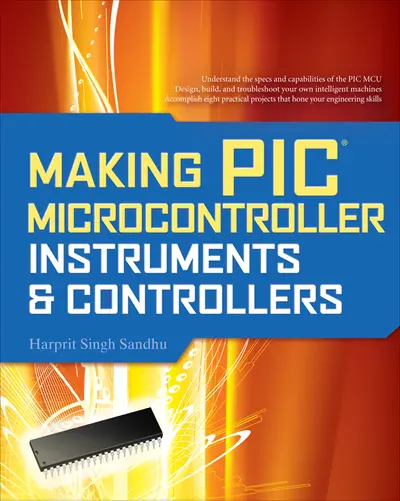My Account Details

ISBN10: 0071606165 | ISBN13: 9780071606165

Step 1 . Download Adobe Digital Editions to your PC or Mac desktop/laptop.
Step 2. Register and authorize your Adobe ID (optional). To access your eBook on multiple devices, first create an Adobe ID at account.adobe.com. Then, open Adobe Digital Editions, go to the Help menu, and select "Authorize Computer" to link your Adobe ID.
Step 3. Open Your eBook. Use Adobe Digital Editions to open the file. If the eBook doesn’t open, contact customer service for assistance.
Publisher's Note: Products purchased from Third Party sellers are not guaranteed by the publisher for quality, authenticity, or access to any online entitlements included with the product.
Essential Design Techniques From the Workbench of a Pro
Harness the power of the PIC microcontroller unit with practical, common-sense instruction from an engineering expert. Through eight real-world projects, clear illustrations, and detailed schematics, Making PIC Microcontroller Instruments and Controllers shows you, step-by-step, how to design and build versatile PIC-based devices. Configure all necessary hardware and software, read input voltages, work with control pulses, interface with peripherals, and debug your results. You'll also get valuable appendices covering technical terms, abbreviations, and a list of sample programs available online.
- Build a tachometer that gathers, processes, and displays data
- Make accurate metronomes using internal PIC timers
- Construct an asynchronous pulse counter that tracks marbles
- Read temperature information through an analog-to-digital converter
- Use a gravity sensor and servos to control the position of a table
- Assemble an eight-point touch screen with an input scanning routine
- Engineer an adjustable, programmable single-point controller
- Capture, log, monitor, and store data from a solar collector
Preface
Part I: The PIC 16F877A
Chapter 1. An Introduction to the PIC 16F877A Microcontroller Unit
Chapter 2. Getting Started: The Hardware and Software Setup
Chapter 3. Understanding Microchip Technology's PIC 16 F877A: A Description of the MCU
Chapter 4. The Software, the Compilers, and the Editor
Chapter 5. Controlling the Output and Reading the Input
Chapter 6. Timers and Counters
Chapter 7. Clocks, Memory, and Sockets
Chapter 8. Serial Communications: Sockets U9 and U10
Chapter 9. Using Liquid Crystal Displays: An Extended Information Resource
Part II: The Projects
Chapter 10. Using Sensors (Transducers)
Chapter 11. Conditioning the Input Signal
Chapter 12. Conditioning the Output Signal
Chapter 13. An Introduction to the Eight Projects
Chapter 14. The Universal Instrument: A Background Discussion
Chapter 15. Counting Pulses: A Programmable Tachometer
Chapter 16. Creating Accurate Intervals with Timers: The Metronomes
Chapter 17. Understanding the Counters: Counting Marbles
Chapter 18. A Dual Thermometer Instrument
Chapter 19. An Artificial Horizon: A Table Surface That Stays Level
Chapter 20. Building a Simple Eight-Button Touch Panel
Chapter 21. Single Set Point Controller with Remote Inhibit Capability
Chapter 22. Logging Data from a Solar Collector
Chapter 23. Debugging
Chapter 24. Some Real-World Projects You Can Build
Conclusion
Appendixes
Appendix A. Setting Up a Compiler for One-Keystroke Operation
Appendix B. Abbreviations Used in this Book and in the Datasheets
Appendix C. Listings of PICBASIC PRO programs on the Internet at melabs.com
Appendix D. Notes on Designing a Simple Battery Monitor Instrument: Thinking about a Simple Problem Out Loud
Appendix E. Using the Support Web Site to Help Make Instruments and Controllers
Index
Need support? We're here to help - Get real-world support and resources every step of the way.